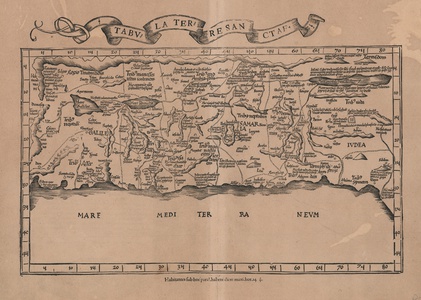| Method | Woodcut |
| Artist | Fries, Lorenz after Waldseemüller, Martin |
| Published | [Melchior and Gaspar Trechsel, Lyon, 1535] |
| Dimensions | 420 x 290 mm |
| Notes |
An important early sixteenth century map of the Holy Land, this particular example the 1535 third edition of Lorenz Fries' reduced edition of Waldseemüller's 1513 woodcut map of the region, printed by the Lyonnais publishers Melchior and Gaspar Trechsel. Both the Fries and Waldseemüller editions of the map are closely based upon the historically significant 'modern' map of the Holy Land designed by the Genoese geographer Pietro Vesconte. The first printed examples appeared in 1482 in the celebrated Ulm Ptolemy, an edition of Ptolemy's Geographia published in Ulm by Lienhart Holle. The map shows the Holy Land divided into the territories of the twelve tribes of Israel, their borders marked as dotted lines. Mountains, lakes, and seas are shown pictorially, as are other unique features such as the Tombs of Job and Rachel, and the Cave of the Patriarchs. Above the map, the title is enclosed in an elaborate ribbon cartouche. On the verso, a lengthy history of the region is bordered by decorative column ornaments traditionally ascribed to Durer. Fries' maps were published in four different editions, by Gruninger in Strasbourg in 1522 and 1525, and, following Fries' death in 1532, by Johann Trechsel in Lyon and Vienne in 1535 and 1541. The Trechsel editions featured text by the Spanish humanist, Michael Servetus, writing in this case under the name Villanovus. Unfortunately for Servetus, his theological treatises drew negative attention from Protestant and Catholic corners alike, and in 1553 he was found guilty of heresy and burned at the stake, and this put paid to any future editions of Fries' atlas. The woodcut borders on the versos of Gruninger and Trechsel's editions are traditionally attributed to Hans Holbein and Durer respectively. Lorenz Fries (c.1490-1532) was born in the Alsace region and studied variously at the universities in Pavia, Vienna, Piacenza and Montpellier. After completing his studies, Fries set himself up as a physician in Alsace, and briefly in Switzerland, before finally settling in Strasbourg in 1519, by which point he had published several medical texts. It was in Strasbourg that Fries meet Johann Gruniger, an associate of the St. Die group of scholars who included Martin Waldseemüller. From 1520 to 1525 Fries worked with Gruniger as his cartographic editor, producing numerous reduced woodblock maps using the vast material of Waldseemüller's 1513 Ptolemaic Atlas. Martin Waldseemüller (11th September, 1470 - 16th March, 1520) was a German author, cartographer, and publisher, and one of the most significant figures in the history of cartography. His most celebrated achievement was the publication in 1507 of his Universalis Cosmographia, a monumental twelve-panel map of the world making use of the discoveries of Columbus and Vespucci, and being the first recorded use of the title 'America' to describe the New World. In addition to this, Waldseemuller's appendix to his Ptolemaic atlas featured some of the very first individual maps of European discoveries in the New World, East Indies, and Western and Southern Africa. Condition: Central vertical fold, as issued. Time toning and old acid burns to sheet. Large patch of paper bleaching to top right corner of sheet. Manuscript numerals in old hand to top left and right corners of sheet. Old adhesive tape residue to verso. Latin text and ornaments to verso. |
| Framing | unmounted |
| Price | £1,250.00 |
| Stock ID | 52793 |

